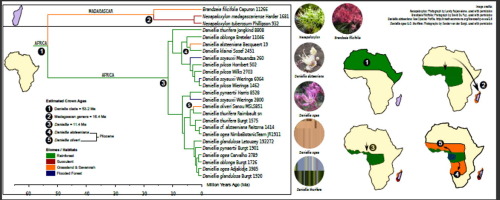当前位置:
X-MOL 学术
›
Mol. Phylogenet. Evol.
›
论文详情
Our official English website, www.x-mol.net, welcomes your feedback! (Note: you will need to create a separate account there.)
Phylogeny and biogeography of the Daniellia clade (Leguminosae: Detarioideae), a tropical tree lineage largely threatened in Africa and Madagascar.
Molecular Phylogenetics and Evolution ( IF 4.1 ) Pub Date : 2020-02-03 , DOI: 10.1016/j.ympev.2020.106752 Le Min Choo 1 , Félix Forest 2 , Jan J Wieringa 3 , Anne Bruneau 4 , Manuel de la Estrella 5
Molecular Phylogenetics and Evolution ( IF 4.1 ) Pub Date : 2020-02-03 , DOI: 10.1016/j.ympev.2020.106752 Le Min Choo 1 , Félix Forest 2 , Jan J Wieringa 3 , Anne Bruneau 4 , Manuel de la Estrella 5
Affiliation

|
The legume subfamily Detarioideae is exceptionally diverse in tropical Africa and Madagascar, compared to South America or Asia, a trend contrary to that shown by most other pantropical plant groups. We aim to elucidate the process of diversification giving rise to these high diversity levels by focussing our investigations on the Daniellia clade, which is present in both Africa and Madagascar. The Daniellia clade is an early-diverging lineage of subfamily Detarioideae (Leguminosae; pea family) and consists of three genera: Daniellia, Brandzeia and Neoapaloxylon. The species belonging to this group exhibit a wide range of habitat types. The Madagascar endemics Brandzeia (1 species) and Neoapaloxylon (3 species) occupy dry woodlands and arid succulent habitats respectively. Daniellia alsteeniana and D. oliveri are found in savannahs while the remaining eight species within Daniellia all occupy rainforest habitats. Phylogenetic analyses were generated from a dense, multi-individual species level sampling of the clade. Divergence time estimates were carried out using a molecular clock method to investigate biogeographical patterns and shifts in habitat types within the Daniellia clade, and conservation assessments were conducted to determine the levels of extinction risks these species are facing. We estimate that the Daniellia clade first emerged during the Early Eocene from an ancestor present in the rainforests of North Africa at that time, reflecting an ancestral habitat preference. There was a first major split over the course of the Eocene, giving rise to both African rainforest and Madagascan savannah lineages. With the emergence of a drier climate and vegetation type in Africa during the Eocene, it is likely that a dry-climate adapted lineage from the Daniellia clade ancestor could have dispersed through suitable savannah or woodland regions to reach Madagascar, subsequently giving rise to the savannah-adapted ancestor of Brandzeia and Neoapaloxylon in the Early Miocene. The African rainforest lineage gave rise to the genus Daniellia, which is postulated to have first diversified in the Middle Miocene, while savannah species of Daniellia emerged independently during the Pliocene, coinciding with the global rise of C4-dominated grasslands. More than half of the species in the Daniellia clade are near threatened or threatened, which highlights the need to understand the threats of anthropogenic pressures and climate change these species are facing to prioritise their conservation.
中文翻译:

丹尼尔利亚进化枝(Leguminosae:Detarioideae)的系统发育和生物地理学,这是一种热带树木谱系,在非洲和马达加斯加受到严重威胁。
与南美或亚洲相比,热带非洲和马达加斯加的豆科亚科异常多样,这一趋势与大多数其他泛热带植物群相反。我们旨在通过将调查重点放在非洲和马达加斯加的丹妮莉亚进化枝上,阐明引起这些高度多样性的多样化过程。Daniellia进化枝是Detarioideae(豆科;豌豆科)亚科的早期分化谱系,由三个属组成:Daniellia,Brandzeia和Neoapaloxylon。属于这一类的物种具有广泛的栖息地类型。马达加斯加的特有物种Brandzeia(1种)和Neoapaloxylon(3种)分别占据干燥的林地和干旱多汁的生境。Daniellia Alsteeniana和D. 在大草原中发现了奥利韦里,而丹妮莉亚内其余的八个物种都居住在热带雨林中。系统进化分析是从进化枝的密集,多个体物种水平采样中产生的。使用分子钟方法进行了发散时间估计,以调查丹尼尔利亚进化枝内的生物地理模式和栖息地类型的变化,并进行了保护性评估以确定这些物种面临的灭绝风险的水平。我们估计,Daniellia进化枝是在始新世初期由当时存在于北非雨林中的祖先出现的,反映出祖先对栖息地的偏好。在始新世过程中发生了第一次重大分裂,产生了非洲雨林和马达加斯加大草原的血统。随着始新世时期非洲气候和植被类型的出现,来自丹尼尔利亚进化枝祖先的适应干旱气候的世系很可能已经散布在适当的大草原或林地地区,到达了马达加斯加,从而形成了大草原。的中新世初期,Brandzeia和Neoapaloxylon的适应祖先。非洲雨林世系产生了Daniellia属,该属被假定在中新世中期首先发生了分化,而Daniellia的热带稀树草原物种则在上新世期间独立出现,这与C4为主的草原的全球兴起相吻合。丹妮莉亚进化枝中一半以上的物种濒临灭绝或威胁,
更新日期:2020-02-03
中文翻译:

丹尼尔利亚进化枝(Leguminosae:Detarioideae)的系统发育和生物地理学,这是一种热带树木谱系,在非洲和马达加斯加受到严重威胁。
与南美或亚洲相比,热带非洲和马达加斯加的豆科亚科异常多样,这一趋势与大多数其他泛热带植物群相反。我们旨在通过将调查重点放在非洲和马达加斯加的丹妮莉亚进化枝上,阐明引起这些高度多样性的多样化过程。Daniellia进化枝是Detarioideae(豆科;豌豆科)亚科的早期分化谱系,由三个属组成:Daniellia,Brandzeia和Neoapaloxylon。属于这一类的物种具有广泛的栖息地类型。马达加斯加的特有物种Brandzeia(1种)和Neoapaloxylon(3种)分别占据干燥的林地和干旱多汁的生境。Daniellia Alsteeniana和D. 在大草原中发现了奥利韦里,而丹妮莉亚内其余的八个物种都居住在热带雨林中。系统进化分析是从进化枝的密集,多个体物种水平采样中产生的。使用分子钟方法进行了发散时间估计,以调查丹尼尔利亚进化枝内的生物地理模式和栖息地类型的变化,并进行了保护性评估以确定这些物种面临的灭绝风险的水平。我们估计,Daniellia进化枝是在始新世初期由当时存在于北非雨林中的祖先出现的,反映出祖先对栖息地的偏好。在始新世过程中发生了第一次重大分裂,产生了非洲雨林和马达加斯加大草原的血统。随着始新世时期非洲气候和植被类型的出现,来自丹尼尔利亚进化枝祖先的适应干旱气候的世系很可能已经散布在适当的大草原或林地地区,到达了马达加斯加,从而形成了大草原。的中新世初期,Brandzeia和Neoapaloxylon的适应祖先。非洲雨林世系产生了Daniellia属,该属被假定在中新世中期首先发生了分化,而Daniellia的热带稀树草原物种则在上新世期间独立出现,这与C4为主的草原的全球兴起相吻合。丹妮莉亚进化枝中一半以上的物种濒临灭绝或威胁,



























 京公网安备 11010802027423号
京公网安备 11010802027423号